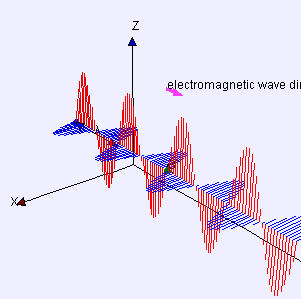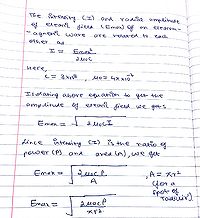Energy and Momentum Analysis in Radiation: Difference between revisions
No edit summary |
No edit summary |
||
| Line 103: | Line 103: | ||
A small laser used as a pointer produces a beam of red light 5mm in diameter and has a power output of 5mW. What is the magnitude of the electric field in the laser beam? | A small laser used as a pointer produces a beam of red light 5mm in diameter and has a power output of 5mW. What is the magnitude of the electric field in the laser beam? | ||
'''Solution''' | '''Solution''' | ||
[[File:Phy1.jpg]] | |||
[[File:Phy1.jpg|200px|Sol 1]] | |||
| Line 112: | Line 116: | ||
A 100 W light bulb is placed in a fixture with a reflector that makes a spot of radius 20 cm. Calculate approximately the amplitude of the radiative electric field in the spot. | A 100 W light bulb is placed in a fixture with a reflector that makes a spot of radius 20 cm. Calculate approximately the amplitude of the radiative electric field in the spot. | ||
'''Solution''' | '''Solution''' | ||
[[File:Phy2.jpg|200px|Sol2: Page 1]] | |||
[[File:Phy3.jpg|200px|Sol2: Page 2]] | |||
Revision as of 00:21, 26 November 2015
The Main Idea
Electromagnetic Radiations in the Classical Model
Electromagnetic radiation can essentially be described as stream of photons. These photons are defined as chargeless and massless, however they have both energy and surprisingly, given their lack of mass, momentum, which can be calculated from their wave properties.
Waves were poorly understood until the 1900s, when Max Planck and Albert Einstein developed modern corrections to classical theory.
Planck theorized that "black bodies" or thermal radiators and other forms of electromagnetic radiation existed not as a continuous spectrum but rather in discrete or "quantized" form. This implied that there were only certain energy values that an electromagnetic wave could have.
In the classical model that we study now it is mentioned that electromagnetic radiation carries both momentum and energy, and can impart both energy and momentum to matter. We shall discuss these ideas in more detail.

Mathematical Model and Related Concepts
Energy in Electromagnetic Radiation
Let's start by understanding how a pulse of electromagnetic radiation would interact with ordinary matter. To see this effect, we shall look at a single charged particle interacting with the electromagnetic radiation which is composed of perpendicular electric and magnetic fields and see what happens when the pulse of radiation goes by.
Until the pulse reaches the charged particle nothing happens. Now let's assume that the electromagnetic radiation has a width of "w" so the pulse would last for a short time (w/c) where c is the speed of light. Now upon the arrival of the pulse, the charged particle (assuming it is positive) experiences a force (F = qE, where E is the magnitude of the electric field in the electromagnetic radiation) in the direction of the electric field that comprises the radiation and this brief impulse i.e. the product of force and time duration gives the charged particle a momentum. According to the Newton's Second Law of Motion:
[math]\displaystyle{ \Delta p = p - 0 = F \Delta t = (qE)*(w/c) }[/math]
Now this interaction is over so quickly that the charged particle hardly has the time to move a significant distance in the direction of the field. However, if attach the charged particle to a spring then it will oscillate to and fro in the direction of applied force. Since the kinetic energy of the charged particle has to come from somewhere, we conclude that it was imparted to the charged particle by the radiation which means that the there must be some energy carried by the electromagnetic radiation which was transferred.
Since the momentum is proportional to the magnitude of the electric field E in the pulse, we have the following:
[math]\displaystyle{ \Delta K = K - 0 \approx \frac{p^2}{2m} = (qE \frac{w}{c})^2(\frac{1}{2m}) }[/math]
Now if we assume that the speed of this charged particle is very small compared to the speed of light then we can see that the radiative energy is directly proportional to the square of the electric field of the radiation. Also by the conservation of energy principle we know that the since the charged particle has gained energy, the radiation should have lost an equal amount of energy and therefore, the electric field E should be smaller after the pulse has accelerated the charged particle.
Energy Density
ENERGY DENSITY IN ELECTRIC AND MAGNETIC FIELDS
[math]\displaystyle{ \frac{Energy}{Volume} = \frac{1}{2} \epsilon_0 E^2 + \frac{1}{2} \frac{1}{\mu_0} B^2 }[/math]
ENERGY DENSITY IN ELECTROMAGNETIC RADIATION
[math]\displaystyle{ \frac{Energy}{Volume} = \frac{1}{2} \epsilon_0 E^2 + \frac{1}{2} \frac{1}{\mu_0} (\frac{E}{c})^2 = \frac{1}{2} \epsilon_0 E^2(1 + \frac{1}{\mu_0 \epsilon_0 c^2}) = \epsilon_0 E^2 }[/math]
Energy Density is related to energy "flux" in joules per second per square meter. We define a "Poynting vector" [math]\displaystyle{ \overrightarrow{S} }[/math], whose magnitude is the rate of energy flux (in watts per square meter) and whose direction is the direction of propagation of the electromagnetic radiation:
ENERGY FLUX
[math]\displaystyle{ \overrightarrow S = \frac{1}{\mu_0} \overrightarrow E \times \overrightarrow B }[/math]
Momentum in Electromagnetic Radiation
We just studied the effect of the electric field in a pulse of radiation which causes a charged object to move in a direction perpendicular to the direction of propagation of the radiation. However, the magnetic field of the radiation also has an interesting effect although it is very small and therefore, hard to observe but we shall discuss that now.
Let's consider the charged particle again. Now when the electric field has imparted some momentum [math]\displaystyle{ \Delta p }[/math] to it, the magnetic field will also exert a force on the moving charge and let's say it has a speed v. On applying the right hand rule and considering both the positively charged particle and negatively charged particle, we realize that the magnetic force is in the same direction regardless of the sign of the charge and this effect that the electromagnetic radiation has on matter is called "radiation pressure". Note that this pressure even acts on neutral matter and that is because it has the same effect on protons and electrons of the neutral matter but this effect is hard to observe since it is a small effect.
The ratio of the average magnetic force to the electric force is as follows:
[math]\displaystyle{ \frac{\overline F_m}{\overline F_e} = \frac{q (v/2) (E/c)}{q E} = \frac{1}{2} \frac{v}{c} }[/math]
Usually, the speed v acquired during the passage of the pulse is very small as compared to the speed of light so the effect of the magnetic field of the radiation is very small as compared to the effect of the electric field.
Momentum Carried by Electromagnetic Radiation
When a charged particle is exposed to a sinusoidal electromagnetic radiation, in the direction of the electric field which is perpendicular to the direction of propagation of the pulse, there is no net gain in momentum and this is because of the alternating electric field whose net electric force on the particle cancels out to be zero.
However, the average magnetic force on the particle would not be zero, as the magnetic force acts in the direction of propagation of the radiation i.e. [math]\displaystyle{ \overrightarrow v }[/math] and therefore, the particle's momentum would increase in the direction of [math]\displaystyle{ \overrightarrow v }[/math]. In the light of this discussion, we define momentum flux as follows:
MOMENTUM FLUX
[math]\displaystyle{ \frac{\overrightarrow S}{c} = \frac{1}{\mu_0 c} \overrightarrow E \times \overrightarrow B }[/math]
The units of momentum flux would be [math]\displaystyle{ W.s/m^3 }[/math] or [math]\displaystyle{ J/m^3 }[/math] or [math]\displaystyle{ N.m/m^3 }[/math] which is [math]\displaystyle{ N/m^2 }[/math]. So the momentum flux has the same dimensions as pressure.
Now by the principle of conservation of momentum we know that if the radiation imparts momentum to a particle, it should lose an equal amount of momentum and therefore, the magnetic field should also be smaller in magnitude after an interaction with matter.
Examples
Simple/Medium
A small laser used as a pointer produces a beam of red light 5mm in diameter and has a power output of 5mW. What is the magnitude of the electric field in the laser beam?
Solution
Error creating thumbnail: sh: /usr/bin/convert: No such file or directory Error code: 127
Difficult
A 100 W light bulb is placed in a fixture with a reflector that makes a spot of radius 20 cm. Calculate approximately the amplitude of the radiative electric field in the spot.
Solution
See also
Are there related topics or categories in this wiki resource for the curious reader to explore? How does this topic fit into that context?
Further reading
Books, Articles or other print media on this topic
External links
Internet resources on this topic
References
- Source: Boundless. “Energy and Momentum.” Boundless Physics. Boundless, 21 Jul. 2015. Retrieved 25 Nov. 2015 from https://www.boundless.com/physics/textbooks/boundless-physics-textbook/electromagnetic-waves-23/electromagnetic-waves-and-their-properties-166/energy-and-momentum-601-11184/
- Matter and Interactions 4th Edition Chabay . Sherwood

